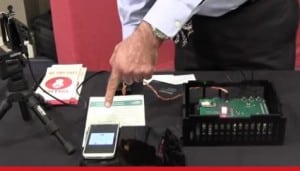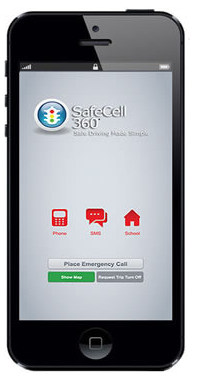 In this video shot at Telematics West Coast, in San Diego Marwan Hannon from Driving Management Systems Inc. shows how technology can stop phone use while driving, notify parents or the driver of alcohol level and help keep drunks off the road.
In this video shot at Telematics West Coast, in San Diego Marwan Hannon from Driving Management Systems Inc. shows how technology can stop phone use while driving, notify parents or the driver of alcohol level and help keep drunks off the road.
The NoComm system disables mobile devices while in the car by deactivating the keyboard of the driver’s smartphone. The DMS is a fully automated system.
The driver can still make and receive phone calls via voice or Bluetooth. The breathalyzer detects alcohol in the air by the driver. The system then alerts the driver and or parents when alcohol is detected.
DMS could be used by insurance companies, in DUI cases and by parents.
The DMS platform will be the size of chip when it finished. Hannon shows the example of a Samsung disabled when in the area of the DMS. A case where the system is handy is when a teenager borrows a friend’s phone to text or call, when a parent has disabled functions on the teens phone. This system blocks out only the driver’s phone.
Hannon was inspired to create DMS from the any near misses with drivers handling devices.
Pricing will be in the range of $300 -$400 when the system is complete.
A case where DMS would have been great, happened in San Diego on Rosecrans Blvd., I noticed to young teenage girls in a BMW convertible. They both had iPhones in their hands and they were looking at them. The driver of course did not notice me. Their attitude was “Don’t we look great.”
The DMS Platform’s NoComm sensor based system identifies, isolates and disables the driver’s mobile device (including wearables) while allowing passengers to use their mobile devices. Emergency calls still work regardless of configuration.
Currently there are apps that help stop texting while driving such as the Otter App, SafeCell 360 and AT&T.
The use of cell phones in cars can be worse than drunk driving. This device is different from a court appointed alcohol ignition interlock device such as those made by Alcohol Countermeasure Systems Corporatio (ACS). The devices do not let the car start unless the driver takes a breath test, by blowing into a mouth piece. Ignition interlocks are often required by judges and legislation for drivers convicted of driving while drunk. The data from the ignition interlock devices are recorded and given to the probation office.
Jake Nelson, director of traffic safety advocacy at AAA reported that first offenders convicted of drunk driving on the average have driven 80 times drunk before getting caught. Nelson says that court ordered devices cost around $200 to install and $3 a day to operate, less than a cost of a drink a day.
At the annual meeting of the APMA (Automotive Parts Manufacturer’s Association) in Canada this year, a special connected Lexus car was demonstrated with an interlock device.
The decked out connected Lexus had a ACS integrated an alcohol interlock handset directly in the car’s computer using the QNX operating system which did not require a separate electronic control unit. The alcohol measurements and driver profiles are seen and set through the infotainment unit. A parent can set levels for a teen and then get text messages or emails with a location and the alcohol level.
In the future a version, a mobile app will allow the administrator to program interlock settings and see breath alcohol tests with GPS coordinates in real time.
Every day in America, another 28 people die as a result of drunk driving crashes. MADD is currently working to pass more legislation such as Alisa’s Law to require the use of ignition interlocks to first-time convicted drunk drivers.
 The next phase of keeping drunks from driving is in the works through DADSS Driver Alcohol Detection System for Safety a program from the Automotive Coalition for Traffic Safety and the National Highway Traffic Safety Administration to research policy challenges for more widespread use of in-vehicle technology to prevent alcohol-impaired driving. The group is considering passive forms of monitoring such as touch or breath detection.
The next phase of keeping drunks from driving is in the works through DADSS Driver Alcohol Detection System for Safety a program from the Automotive Coalition for Traffic Safety and the National Highway Traffic Safety Administration to research policy challenges for more widespread use of in-vehicle technology to prevent alcohol-impaired driving. The group is considering passive forms of monitoring such as touch or breath detection.
This device may fit the future guidelines of the DADSS and could prevent a multitude of unnecessary accidents and deaths. NHTSA or DADSS could possibly make this type of device mandatory in all vehicles. TEXTING/EMAIL and any use of the mobile device while driving is estimate to cause at very 3,000 deaths and 400,000 injuries per year.






